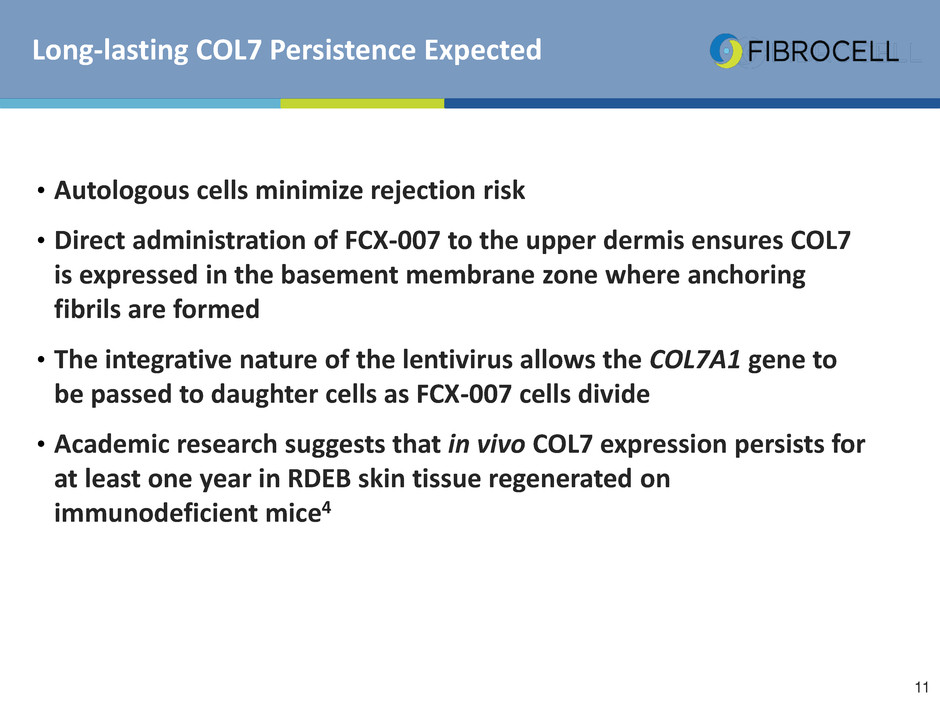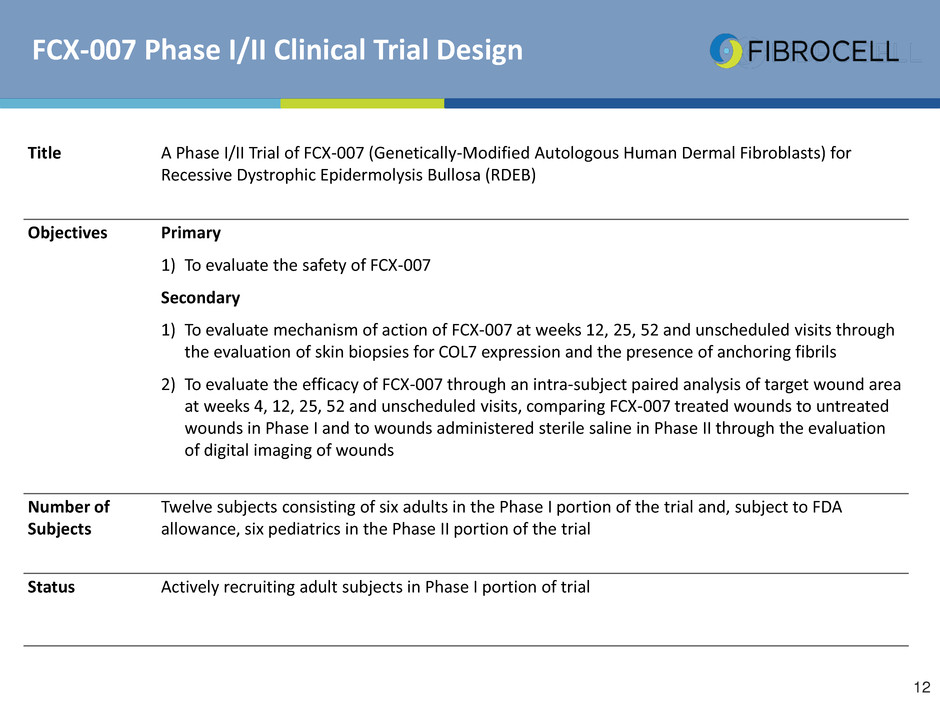
Corporate Presentation October 5, 2016

This presentation and our accompanying remarks contain “forward-looking statements” within the meaning of the U.S. Private Securities Litigation Reform Act of 1995. All statements that are not historical facts are hereby identified as forward-looking statements for this purpose and include, among others, statements relating to: the potential advantages of our product candidates; the initiation, design and timing of pre-clinical and clinical studies and activities and the reporting of the results thereof; the timing of regulatory submissions and actions; expected milestones; and all other statements relating to our future operations, future financial performance, future financial condition, prospects or other future events. Forward-looking statements are based upon our current expectations and assumptions and are subject to a number of known and unknown risks, uncertainties and other factors that could cause actual results to differ materially and adversely from those expressed or implied by such statements. Factors that could cause or contribute to such differences include, among others: our ability to obtain additional capital to fund our operations; FDA allowance to treat pediatric subjects in the Phase II portion of our Phase I/II clinical trial of FCX-007; uncertainties relating to the initiation, enrollment and completion of clinical trials and whether the results will validate and support the safety and efficacy of our product candidates; the risk that results seen in pre-clinical studies may not be replicated in humans; varying interpretation of pre-clinical and clinical data; our ability to maintain our collaborations with Intrexon; and the other factors discussed under the caption “Item 1A. Risk Factors” in our most recent Form 10-K and Form 10-Q filings which are available through the “Investors—SEC Filings” page of our website at www.fibrocell.com. As a result, you should not place undue reliance on forward-looking statements. The forward-looking statements made in connection with this presentation represent our views only as of the date of this presentation (or any earlier date indicated in such statement). While we may update certain forward-looking statements from time to time, we specifically disclaim any obligation to do so, even if new information becomes available in the future. 2 Forward-Looking Statements

Company Highlights •Autologous cell and gene therapy company translating personalized biologics into medical breakthroughs for diseases of the skin and connective tissue •FCX-007 — Recessive Dystrophic Epidermolysis Bullosa (RDEB) Actively recruiting adult subjects; first human clinical data expected in 3Q17 Granted pediatric rare disease designation by FDA • FCX-013 — Linear Scleroderma Proof-of-concept completed January 2016; IND planned 4Q17 Granted orphan drug designation by FDA for localized scleroderma • Arthritis and related conditions Deliver therapeutic protein locally to the joint providing sustained efficacy while avoiding key side effects typically associated with systemic therapy •Portfolio being developed in collaboration with Intrexon 3

Key Advantages of Our Autologous Fibroblast Gene Therapy Platform • Fibroblasts are the most common cell in skin and connective tissue, and are an ideal delivery vehicle to administer protein of interest locally Localized administration avoids side effects typically associated with systemic therapy Reduced rejection and immunogenicity concerns because autologous fibroblasts are compatible with the unique biology of each patient • Use of a 3rd generation, self-inactivating (SIN) lentivirus: Accommodates large gene constructs due to packaging size Allows for target gene integration, ideal for long-term expression of the protein • Fibroblasts are genetically modified ex vivo, providing distinct safety and efficacy advantages: Enables testing for safety and confirmation of transduction rates and protein expression prior to administration Reduces potential for host immune response upon retreatment as live virus is not administered directly into the patient •We are using our proprietary technology to create personalized biologics Expertise in commercial-scale manufacturing of an autologous cell therapy 4

Personalized Biologics Approach 5

Development Pipeline 6 Personalized Biologic Indication Research Pre-Clinical Development Human Clinical Trials FCX-007 Recessive Dystrophic Epidermolysis Bullosa (RDEB) FCX-013 Linear Scleroderma Research Program Arthritis

Recessive Dystrophic Epidermolysis Bullosa 7 Disease Current Treatments Epidemiology • Cause: A mutation in the COL7A1 gene that encodes for COL7 • Devastating, progressive, painful blistering disease that often leads to death • Diagnosed at infancy • High mortality rate • Current treatments only address symptoms Bandaging & antibiotics – bandaging alone can exceed $10,000 per month1 Feeding tubes Surgery, including hand and esophageal Dystrophic EB (DEB) ~5,500 – 12,500 US2 • RDEB ~1,100 – 2,500 US3

FCX-007 Providing Hope for RDEB Patients 8 RDEB patients do not produce type VII collagen (COL7) due to mutation in COL7A1 gene Main component of anchoring fibrils that connect skin layers FCX-007 is an autologous human dermal fibroblast transduced with a lentiviral (LV) vector encoded for COL7A1 Simple, local injection to the papillary dermis

COL7 Expression Confirmation 9 Culture supernatant evaluated for in vitro COL7 expression • ELISA assay indicates virus dose-dependent protein expression • Trimeric form of COL7 produced by RDEB patient fibroblasts transduced with LV-COL7 •Must be trimeric to be functional Reference: Bruckner-Tuderman, Leena. Can Type VII Collagen Injections Cure Dystrophic Epidermolysis Bullosa? Molecular Therapy (2008) 17 1, 6–7. RDE B + C o n tr o l P u ri fi e d C OL 7 FC X -0 0 7 -0 1 FC X -0 0 7 -0 2 Trimeric COL7 (900kDa) COL7 IP Immunoprecipitation (IP)/Western Blot COL7 Formation Trimeric Form (900kDa)

10 Detection of COL7 Expression by Immunofluorescence (Magnification 20x) • In vitro COL7 expression noted from FCX-007 replicates (red) • FCX-007 expresses higher levels of COL7 than normal human dermal fibroblasts (NHDF) as depicted by a brighter signal • No expression of COL7 in RDEB-positive fibroblasts FCX-007 Rep 1 FCX-007 Rep 2 FCX-007 In Vivo Expression*In Vitro Expression NHDF RDEB+ NHDF RDEB+ • RDEB xenograft on immunodeficient mouse sampled 17 days post-injection • COL7 detected at the basement membrane zone (BMZ; refer to arrow) and underlying dermis (green) • NDHF slide expresses COL7 normally resulting in mature anchoring fibrils • No expression of COL7 in RDEB-positive fibroblasts*Image courtesy of Peter Marinkovich, MD lab, Stanford University COL7 expression at BMZ only 17 days after injection of FCX-007

• Autologous cells minimize rejection risk • Direct administration of FCX-007 to the upper dermis ensures COL7 is expressed in the basement membrane zone where anchoring fibrils are formed • The integrative nature of the lentivirus allows the COL7A1 gene to be passed to daughter cells as FCX-007 cells divide • Academic research suggests that in vivo COL7 expression persists for at least one year in RDEB skin tissue regenerated on immunodeficient mice4 11 Long-lasting COL7 Persistence Expected

FCX-007 Phase I/II Clinical Trial Design 12 Title A Phase I/II Trial of FCX-007 (Genetically-Modified Autologous Human Dermal Fibroblasts) for Recessive Dystrophic Epidermolysis Bullosa (RDEB) Objectives Primary 1) To evaluate the safety of FCX-007 Secondary 1) To evaluate mechanism of action of FCX-007 at weeks 12, 25, 52 and unscheduled visits through the evaluation of skin biopsies for COL7 expression and the presence of anchoring fibrils 2) To evaluate the efficacy of FCX-007 through an intra-subject paired analysis of target wound area at weeks 4, 12, 25, 52 and unscheduled visits, comparing FCX-007 treated wounds to untreated wounds in Phase I and to wounds administered sterile saline in Phase II through the evaluation of digital imaging of wounds Number of Subjects Twelve subjects consisting of six adults in the Phase I portion of the trial and, subject to FDA allowance, six pediatrics in the Phase II portion of the trial Status Actively recruiting adult subjects in Phase I portion of trial

Linear Scleroderma 13 Disease Epidemiology • Excess production of collagen I and III characterized by skin fibrosis and linear scars • The linear areas of skin thickening may extend to underlying tissue and muscle in children which may impair growth in affected legs and arms or forehead • Lesions appearing across joints impair motion and may be permanent • Localized Scleroderma ~160,000 sufferers US5 comprised of many different sub-types Linear Scleroderma Initial target for FCX-013 is a group of ~40,000 patients6 Current Treatments Current treatments only address symptoms: • Systemic or topical corticosteroids • UVA light therapy • Physical therapy Photo: Reprinted from the Journal of the American Academy of Dermatology, Volume 59, Issue 3, Stéphanie Christen-Zaech, Miriam D. Hakim, F. Sule Afsar, Amy S. Paller. Pediatric morphea (localized scleroderma): Review of 136 patients, Figure 1, pp. 385-396. Copyright Sept 2008. Used with permission from Elsevier Ltd.

FCX-013 Development Progressing 14 •Product profile Autologous fibroblasts genetically modified using lentivirus and encoded for a protein responsible for breaking down excess collagen I and III Target protein known to breakdown collagens Incorporates Intrexon’s RheoSwitch Therapeutic System® (RTS®) to control protein expression • RTS® has previous human clinical trial experience •Proof-of-concept animal study data demonstrated protein expression, reduced thickness of fibrotic tissue • Scale-up manufacturing in process •Received FDA orphan drug designation for treatment of localized scleroderma •Next steps include dose-ranging and toxicology/biodistribution studies •IND submission expected 4Q17

FCX-013 Proof-of-Concept Study 15 • Study Design Bleomycin treated SCID mouse model N=30 mice over test and control groups Assessed histologically for reduction of dermal thickness and sub-dermal muscle in the presence of FCX-013 and oral ligand • Result Bleomycin treatment resulted in skin fibrosis, measured by a significant increase in dermal thickness Demonstrated that FCX-013 with ligand reduced the dermal thickness of fibrotic tissue to levels similar to non-bleomycin (saline) with ligand treated skin Further reduced the thickness of the sub-dermal muscle layer Blecomycin treatments Ligand Treatment D0 D28 D29 D39 Cell injection Harvest skin samples CONTROL: Saline (no Bleo) No Cells TEST: Bleomycin FCX-013 CONTROL: Bleomycin Non-Modified Cells

• FCX-013 employs Intrexon’s RheoSwitch Therapeutic System® (RTS®) The RTS® biologic switch is activated by an orally- administered activator ligand (AL) that provides the ability to control level and timing of protein expression • Enhances the safety profile of FCX-013 by providing control over the expression of the protein • In vitro studies support RTS® control over FCX- 013 protein expression: Significant increase in expression of the target protein in the presence of the AL In the absence of the AL, the expression is reduced to normal cellular production of the target protein Cells transduced with RTS® and off-target gene construct (RTS-GFP) and non-transduced fibroblasts (mock) express normal cellular production levels 16 RheoSwitch® Control RTS-GFP Control FCX-013 Mock Control FCX-013 RTS® Control no AL + AL Ta rg et P ro tein Conce n tr ati o n

Research Program for Arthritis 17 •Deliver therapeutic protein locally to the joint providing sustained efficacy while avoiding key side effects typically associated with systemic therapy •Combines Fibrocell’s autologous fibroblast technology with Intrexon’s cellular engineering to develop localized gene therapies •Focused on addressing chronic inflammation and degenerative diseases of the joint, including arthritis

Milestones 18 Milestones Anticipated Timing FCX-007 1st Adult Subject Dosed Yearend 2016 FCX-007 Phase I/II Trial First human clinical data 3Q17 FCX-013 IND Submission 4Q17

Company Highlights •Autologous cell and gene therapy company translating personalized biologics into medical breakthroughs for diseases of the skin and connective tissue •FCX-007 — Recessive Dystrophic Epidermolysis Bullosa (RDEB) Actively recruiting adult subjects; first human clinical data expected in 3Q17 Granted pediatric rare disease designation by FDA • FCX-013 — Linear Scleroderma Proof-of-concept completed January 2016; IND planned 4Q17 Granted orphan drug designation by FDA for localized scleroderma • Arthritis and related conditions Deliver therapeutic protein locally to the joint providing sustained efficacy while avoiding key side effects typically associated with systemic therapy •Portfolio being developed in collaboration with Intrexon 19

References 1The Dystrophic Epidermolysis Research Association of America (DebRA). DEB brochure, page 6: http://www.debra.org/pdfs/Debra-of-America-Brochure.pdf; accessed 07/20/15. 2DEBRA International. What is EB Infographic: http://www.debra- international.org/epidermolysis-bullosa.html.; accessed 10/06/2014. 3Petrof G., et al. Fibroblast cell therapy enhances initial healing in recessive dystrophic epidermolysis bullosa wounds: results of a randomised, vehicle- controlled trial. Brit J Dermatol. 2013 Nov;169(5):1025-33. 4Siprashvili Z., et al. Long-term type VII collagen restoration to human epidermolysis bullosa skin tissue. Human Gene Therapy. 2010 Oct;21(10): 1299- 1310. 5Data on file, Fibrocell Science. 6Leitenberger, et. al. Distinct autoimmune syndromes in morphea: a case study of 245 adult and pediatric cases. Arch Dermatol. 2009 May;145(5):545-550. 20



















